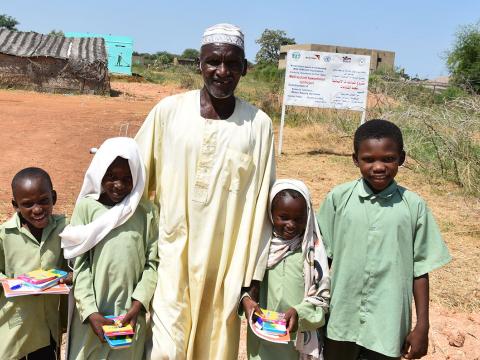Improved school environment encourages extra school admission

Story by Gamal Ghallab, WV Sudan communications officer
More children are going to school in a village in Sudan, thanks to a project that means pupils now have access to clean latrines and safe drinking water.
This time last year there was no latrines and very limited water at Al Rayan Mixed Basic School in al Azaza village of al Rosaries locality, Blue Nile state. As such it was hard to keep the children at school for more than two hours, because there was not enough for them to drink.
"We had a water container provided by Parents, Teachers Association (PTA) (last year but it was too small to provide the children with enough water all the day," says Izdihahar Adam, the school headmistress.
She now does not need to worry about how to keep the students at the school as World Vision has installed a 1,000-litre water tank.
"The intervention of World Vision and its partners has changed the face of the school," says Adam.
World Vision, funded by Sudan Humanitarian Fund, is implementing with other national and international organisations, the Multi-Sector Consortium Humanitarian Assistance Project forInternally Displaced Persons (IDPs), host, refugees, and returnee communities in four areas of the Blue Nile state.
World Vision distributed learning materials for all the 216 children and provided the teachers at the school with teaching materials. These materials include exercise books, crayons, geometry sets, pens and pencils for the students, chalk, notebooks and teaching clocks.
During the distribution of the teaching and learning materials, we met nine-year-old al Tayeb, who studies in the first grade at the school. "I'm happy because I have received a set of colored pens today and I can draw beautiful paintings," little al Tayeb says cheerfully.
Abdullah, al Tayeb’s father, is a farmer and wishes to support his children until they graduate from university. "I would like to thank World Vision as it solves some complicated troubles hindering many parents from sending their children to school," he says.
However there is still work to do.
"Although the construction of the two latrines with the installation of the water tank and the distribution of the teaching and learning materials have contributed to the settling down of the students, we still have much to do," says head of the school PTA Abdul Raziq Adam.
He explains that the school has only one semi permanent structure. The simple facility consists of one classroom and one teachers' office while the rest of the children study in two rooms made of straw.
"We are required to add at least one more classroom for the children who will be admitted the coming school year, and because our financial resources are so limited, we don't have another option but constructing an additional room from straw.”
With more funding, perhaps this school can get their wish.
But worth noting is that the SHF project has supported the construction of permanent classrooms in nine schools, providing teaching and learning materials as well teacher training. The goal is to improve the quality of education and boost the learning and teaching experience,” says Getenew Zewdu, the Consortium Manager for the project.
“Children are likely to be attracted to school and stay longer-because of the conducive learning environment,” Getenewadds.
In fact, in 2017 there were 165 children in the school, the number went up to 216 in 2018, which is a reflection of the impact of the project,” Getenew notes.
PANCARE, another consortium member installed a water tank in the school, two latrines attached with hand water facilities (stationed separately for both boys and girls).
World Vision is implementing this integrated project in partnership with Adventist Development and Relief Agency (ADRA) Friends for Peace and Development Organisation, JASMAR, and Pancare.
